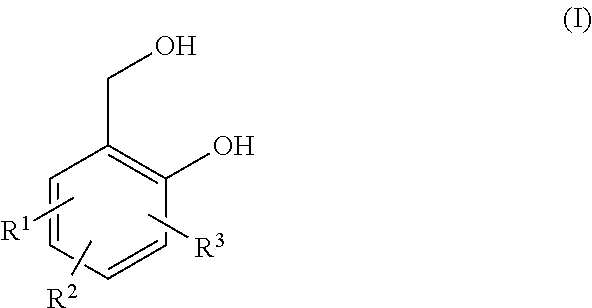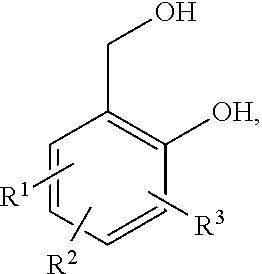New reactive polymer catalysts for 2-component epoxy resin systems
a reactive polymer and epoxy resin technology, applied in the direction of organic compound/hydride/coordination complex catalysts, physical/chemical process catalysts, adhesive types, etc., can solve the problems of mannich bases, unsuitable for many applications, and use of phenol as a starting material
- Summary
- Abstract
- Description
- Claims
- Application Information
AI Technical Summary
Benefits of technology
Problems solved by technology
Method used
Image
Examples
example 1
[0065]A vessel was filled with 180 g (0.88 mol) Jeffamin EDR 176 and 99 g (0.58 mol) 2,6-bis(hydroxymethyl)-p-cresol and heated in a nitrogen atmosphere. Once a homogeneous mixture had been obtained (at approximately 50° C.), the temperature was increased successively to 180° C., wherein steady boiling was observed beyond a temperature of 160° C. In the range of 180 to 178° C., a total of 66 mL of a distillate was obtained. The product was obtained in the form of a viscous, yellowish-clear polymer as residue.
example 2
[0066]90 g 4,7-dioxa-1,10-decanediamine and 60 g 2,6-bis(hydroxymethyl)-p-cresol was placed in a vessel and heated successively to a temperature of 178° C. Within the range of 165° C. to 170° C., a total of 16 mL of a distillate was collected. The product was obtained in the form of a viscous, yellowish-clear polymer as residue.
example 3
[0067]120 g Jeffamin D 230 and 60 g 2,6-bis(hydroxymethyl)-p-cresol was placed in a vessel and heated successively to a temperature of 184° C. At a temperature of 184° C., a total of 12 mL of a distillate was collected. The product was obtained in the form of a viscous, yellowish-clear polymer as residue.
Example 4
[0068]120 g (1.18 mol) 4,9-dioxa-1,12-dodecanediamine, 20 g (0.36 mol) resorcinol and 60 g (0.71 mol) 2,6-bis(hydroxymethyl)-p-cresol was placed in a vessel and heated successively to a temperature of 175° C. At this temperature, a total of 8 mL of a distillate was collected. Afterward, a substantial increase in viscosity and gelation was observed. The product was not usable.
Example 5
[0069]120 g (1.18 mol) 4,9-dioxa-1,12-dodecanediamine, 10 g (0.18 mol) resorcinol and 70 g (0.83 mol) 2,6-bis(hydroxymethyl)-p-cresol was placed in a vessel and heated successively to a temperature of 173° C. At this temperature, a total of 10 mL of a distillate was collected. Afterward, a subs...
PUM
| Property | Measurement | Unit |
|---|---|---|
| Temperature | aaaaa | aaaaa |
| Temperature | aaaaa | aaaaa |
| Temperature | aaaaa | aaaaa |
Abstract
Description
Claims
Application Information
 Login to View More
Login to View More - R&D
- Intellectual Property
- Life Sciences
- Materials
- Tech Scout
- Unparalleled Data Quality
- Higher Quality Content
- 60% Fewer Hallucinations
Browse by: Latest US Patents, China's latest patents, Technical Efficacy Thesaurus, Application Domain, Technology Topic, Popular Technical Reports.
© 2025 PatSnap. All rights reserved.Legal|Privacy policy|Modern Slavery Act Transparency Statement|Sitemap|About US| Contact US: help@patsnap.com



